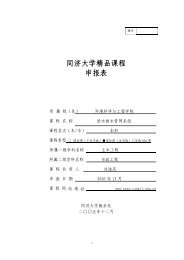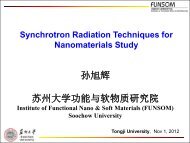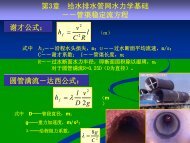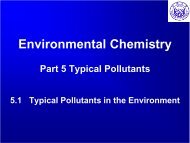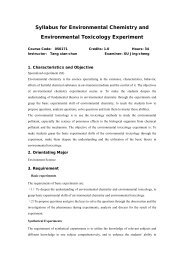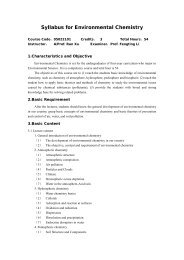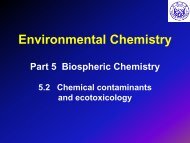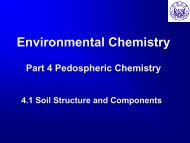Stratospheric Ozone Depletion
Stratospheric Ozone Depletion
Stratospheric Ozone Depletion
Create successful ePaper yourself
Turn your PDF publications into a flip-book with our unique Google optimized e-Paper software.
Environmental Chemistry<br />
Part 2 Atmospheric Chemistry<br />
2.6 <strong>Stratospheric</strong> <strong>Ozone</strong> <strong>Depletion</strong>
<strong>Ozone</strong> in the atmosphere
The ozone layer
Ultraviolet protection by ozone<br />
<strong>Ozone</strong> absorbs UV light in the solar irradiation that is<br />
harmful to life
Ultraviolet protection by ozone<br />
The overlap of ground level radiation with the sunburn<br />
sensitivity curve would be much greater without the filtering<br />
effects of the ozone layer.
Express ozone abundance<br />
• Total column ozone is the total amount of ozone<br />
integrated from the surface to the top of the<br />
atmosphere.<br />
• Dobson Units (DU) is used to express the total column<br />
ozone, named after G.M.B. Dobson, a scientist who<br />
conducted pioneering measurements of the<br />
stratosphere in the 1920s and 1930s.<br />
• One DU is the thickness, measured in units of<br />
hundredths of a millimeter (0.01 mm), that the ozone<br />
column would occupy at standard temperature and<br />
pressure (273 K and 1 atm)
Typical ozone column values<br />
• Total ozone column value ranges from 290 to<br />
310 DU over the globe.<br />
• If all the atmosphere's ozone were brought<br />
down to the earth's surface at standard<br />
pressure and temperature, it would produce a<br />
layer of about 3mm thick.<br />
• <strong>Ozone</strong> depletion: when sum of ozone over<br />
height is lower than 2/3 of the normal value,<br />
we say "ozone depletion" occurs.
What is ozone?<br />
<strong>Ozone</strong> is a stable molecule<br />
composed of three oxygen atoms. O<br />
While stable, it is highly reactive. The Greek word ozein<br />
means “to smell” and O 3 has a strong pungent odor.<br />
Electric discharges in air often produce significant<br />
quantities of O 3 and you may have smelled O 3 near these<br />
sources.<br />
O<br />
O
<strong>Ozone</strong> formation and destruction in the<br />
stratosphere
Chapman Theory<br />
a) O 2 + hv ( 2O<br />
b) O+O 2 +M -> O 3 +M<br />
c) O 3 + hv (
Prediction by Chapman theory vs. Observation<br />
Using Chapman theory
There must be other O 3 destruction pathways<br />
Catalytic ozone destruction<br />
Net reaction<br />
X + O 3 = XO + O 2<br />
XO + O = X + O 2<br />
O + O 3 = 2 O 2<br />
X is a regenerated in the process – act as a catalyst.<br />
The chain reaction continues until X is removed by some<br />
side reaction.
The important catalysts for stratospheric<br />
O 3 destruction<br />
• Hydroxy radical (OH)<br />
. .<br />
OH + O3 = HO2 + O2<br />
HO 2<br />
. + O = . OH + O2<br />
Net: O + O 3 = 2O 2<br />
• Chlorine and bromine (Cl and Br)<br />
Cl . + O 3 = ClO . + O 2<br />
ClO . + O = Cl . + O 2<br />
Net: O + O 3 = 2O 2<br />
• Nitric oxide (NO)<br />
NO + O 3 = NO 2 + O 2<br />
NO 2 + O = NO + O 2<br />
Net: O + O 3 = 2 O 2<br />
HOx cycle<br />
ClOx cycle<br />
NOx cycle
Hydroxy radical<br />
• Accounts for nearly one-half of the total ozone<br />
destruction in the lower stratosphere (16-20 km).<br />
• Sources<br />
O3 + hv (
Chlorine atom<br />
Sources:<br />
Photolysis of Cl-containing compounds in the stratosphere.<br />
CFCl3 + hv (185-210nm) CFCl .<br />
2 + Cl .<br />
CF2 Cl2 + hv (185-210nm) CF2 Cl . + Cl .<br />
Subsequent reactions of CFCl2 and CF2 Cl more Cl atoms<br />
The principal Cl-containing species are:<br />
CF2 Cl2 , CFCl3 , CFCl2 , CF2 Cl, CCl4 , CH3 CCl3 , CF2 HCl, CH3 Cl<br />
Sources for Cl-containing compounds (need to be long-<br />
lived in the troposphere)<br />
•Man-made: e.g. CFCs<br />
•Natural: e.g. methyl chloride from biomass burning.
Chlorofluorocarbons (CFCs)<br />
• CFCs is the abbreviated form of ChloroFluoroCarbons, a<br />
collective name given to a series of compounds<br />
containing chlorine, fluorine and carbon atoms.<br />
Examples: CFCl 3 , CF 2 Cl 2 , and CF 2 ClCFCl 2 .<br />
• Related names<br />
– HCFCs: Hydrochloroflorocarbons, halocarbons<br />
containing hydrogen atoms in addition to chlorine,<br />
fluorine and carbon atoms.<br />
– HFCs: hydroflorocarbons, halocarbons containing<br />
atoms of hydrogen in addition to fluorine and carbon<br />
atoms.<br />
– Perhalocarbons: halocarbons in which every available<br />
carbon bond contains a haloatoms.<br />
– Halons: bromine-containing halocarbons, especially<br />
used as fire extinguishing agents.
Chlorine atom (Continued)<br />
Termination reactions for Cl<br />
Cl . + CH 4 <br />
ClO . + NO 2 + M<br />
Reservoir species<br />
CH 3 . + HCl<br />
Stable in the stratosphere<br />
Removed from air by precipitation<br />
when it migrates to the troposphere<br />
ClONO 2 + M<br />
Relatively unreactive but can regenerate<br />
reactive species upon suitable conditions<br />
ClONO 2 + hvClO + NO 2<br />
ClONO 2 + hvCl + NO 3
Nitric oxide<br />
• NO is produced abundantly in the troposphere,<br />
but all of it is converted into NO2 HNO3 (removed through precipitation)<br />
• NO in the stratosphere produced from nitrous<br />
oxide (N2 O), which is much less reactive than NO.<br />
N2 O + hv N2 + O (90%)<br />
N2 O + O 2 NO (~10%)<br />
• Removal processes:<br />
NO2 + . OH HNO3 ClO . + NO2 ClONO2 Inhibit the HOx<br />
and ClOx cycles
The two-sided effect of NOx<br />
• NOx provides a catalytic chain mechanism for<br />
O 3 destruction.<br />
• NOx inhibit the HOx and ClOx cycles for O 3<br />
destruction by removing radical species in the<br />
two cycles.<br />
• The relative magnitude of the two effects is<br />
altitude dependent.<br />
– >25 km, the net effect is to destruct O 3 .<br />
– (NOx accounts for >50% of total ozone destruction<br />
in the middle and upper troposphere.)<br />
– In the lower stratosphere, the net effect is to protect<br />
O 3 from destruction.
The catalytic destruction reactions described so far,<br />
together with the Chapman cycle, account for the<br />
observed average levels of stratospheric ozone, they<br />
are unable to account for the ozone hole over<br />
Antarctica.<br />
The ozone depletion in the Antarctica is limited both<br />
regionally and seasonally. The depletion is too great<br />
and too sudden. These observations can not be<br />
explained by catalytic O 3 destruction by ClOx alone.
Numbering system for CFCs and HCFCs<br />
CFC-XYZ<br />
1) Z = number of fluorine atoms.<br />
2) Y =1 + number of hydrogen atoms.<br />
3) X = number of carbon atoms -1<br />
When X=0 (i.e., only one carbon compound), it is omitted.<br />
4) The number of chlorine atoms in the compound is found by<br />
subtracting the sum of fluorine and hydrogen atoms from the<br />
total number of atoms that can be connected to the carbon<br />
atoms.<br />
5) Examples:<br />
CCl2F2 (CFC-12, refrigerant)<br />
CCl3F (CFC-11, blowing agent)<br />
CHClF2 (CFC-22, refrigerant, blowing agent)<br />
C2Cl2F4 (CFC-114)
The <strong>Ozone</strong> Hole
The discovery of the ozone hole<br />
• The British Antarctic Survey has been monitoring, for<br />
many years, the total column ozone levels at its base<br />
at Halley Bay in the Antarctica.<br />
• Monitoring data indicate that column ozone levels<br />
have been decreasing since 1977.<br />
• This observation was later confirmed by satellite data<br />
(TOMS-Total <strong>Ozone</strong> Mapping Spectrometer)<br />
– Initially satellite data were assumed to be wrong<br />
with values lower than 190DU
October ozone hole over Antarctic
Features of the ozone hole<br />
• <strong>Ozone</strong> depletion occurs at altitudes between 10<br />
and 20 km<br />
– If O3 depletion resulted from the ClOx cycle, the<br />
depletion would occur at middle and lower latitude<br />
and altitudes between 35 and 45 km.<br />
– The ClOx cycle requires O atom, but in the polar<br />
stratosphere, the low sun elevation results in<br />
essentially no photodissociation of O2 .<br />
– The above observation could not be explained by<br />
the ClOx destruction mechanism alone.<br />
• <strong>Depletion</strong> occurs in the Antarctic spring
Special Features of Polar Meteorology<br />
• During the winter polar night, sunlight does not reach the<br />
south pole.<br />
• A strong circumpolar wind develops in the middle to lower<br />
stratosphere; These strong winds are known as the 'polar<br />
vortex'.<br />
• In the winter and early spring, the polar vortex is<br />
extremely stable, sealing off air in the vortex from that<br />
outside.<br />
• The exceptional stability of the vortex in Antarctic is the<br />
result of the almost symmetric distribution of ocean<br />
around Antarctica.<br />
• The air within the polar vortex can get very cold.<br />
• Once the air temperature gets to below about -80C (193K),<br />
Polar <strong>Stratospheric</strong> Clouds (or PSCs for short) are formed.
Polar vortex<br />
• The polar vortex is a persistent large-scale<br />
cyclonic circulation pattern in the middle and<br />
upper troposphere and the stratosphere,<br />
centered generally in the polar regions of<br />
each hemisphere.<br />
• The polar vortex is not a surface pattern. It<br />
tends to be well expressed at upper levels of<br />
the atmosphere (> 5 km).
Polar <strong>Stratospheric</strong> Clouds (PSCs)<br />
• PSCs first form as nitric acid trihydrate (HNO 3 . 3H2 O)<br />
once temperature drops to 195K.<br />
• As the temperature gets colder, larger droplets of<br />
water-ice with nitric acid dissolved in them can form.<br />
• PSCs occur at heights of 15-20km.
Why do PSCs occur at heights of 15-20 km?<br />
• The long polar night produces temperature as<br />
low as 183 k (-90oC) at heights of 15 to 20<br />
km.<br />
• The stratosphere contains a natural aerosol<br />
layer at altitudes of 12 to 30 km.
PSCs promote the conversion of inorganic Cl<br />
and Cl reservoir species to active Cl<br />
Pathway 1 : HCl(g) Cl2 (g)<br />
• Absorption of gaseous HCl by PSCs occurs very<br />
efficiently<br />
HCl(g) HCl(s)<br />
• Heterogeneous reaction of gaseous ClONO2 with HCl<br />
on the PSC particles<br />
HCl(s) + ClONO2 HNO3 (s) + Cl2 where s denotes the PSC surface<br />
Note: The gas phase reaction between HCl and ClONO 2 is<br />
extremely slow.
PSCs promote the conversion of inorganic Cl<br />
and Cl reservoir species to active Cl<br />
(Continued)<br />
• Pathway 2: HCl(g)ClNO2 (g) in the presence of<br />
N2 O5 HCl(g) HCl(s)<br />
HCl(s) + N 2 O 5 <br />
ClNO 2 + HNO 3 (s)<br />
• Pathway 3: ClONO 2 (g)HOCl (g)<br />
ClONO 2 + H 2 O (s) <br />
HOCl + HNO 3 (s)<br />
The gas phase reactions between HCl and N 2 O 5 ,<br />
between ClONO 2 and H 2 O are too slow to be important.
Why PSCs promote the conversion of inorganic<br />
Cl and Cl reservoir species to active Cl?<br />
1. PSCs concentrate the reactant molecules.<br />
2. Formation of HNO3 is assisted by hydrogen bonding<br />
to the water molecules in the PSC particles.
Active Cl species can rapidly yield Cl<br />
atoms when light is available<br />
• Active Cl species include Cl2 , HOCl, and ClNO2 • Active Cl species readily photolyze to yield Cl atoms<br />
when daylight returns in the springtime.<br />
Cl2 + hv 2Cl<br />
HOCl + hv HO + Cl<br />
ClNO2 + hv Cl + NO2
Polar ClOx cycle to remove O 3<br />
• Polar regions: lack of O atom because of low sun<br />
elevation The ordinary ClOx cycle is not operative<br />
since it requires the presence of O atom.<br />
• Under polar atmospheric conditions, the reaction<br />
sequence to remove O3 is as follows<br />
Cl + O3 ClO + O2 ClO + ClO ClO-OCl<br />
ClO-OCl + hv ClOO + Cl<br />
ClOO + hv Cl + O2 2 [Cl + O3 ClO + O2 ]<br />
Net of the last FOUR reactions: 2O3 + hv <br />
3O 2
How does the polar ClOx cycle stop?<br />
• The chain reaction is stopped when the ice particles<br />
melt, releasing adsorbed HNO3 .<br />
– HNO3 + hv <br />
.<br />
OH + NO2<br />
• NO2 sequesters ClO . , which shuts down the polar<br />
ClOx chain reaction<br />
– NO2 + . ClO <br />
ClONO 2
Evidence linking ClO generation and O 3 loss<br />
ClO mixing ratios in the high-latitude stratosphere are<br />
several orders of magnitude higher than those in the mid-<br />
latitude stratosphere.
Denitrification by PSCs enhances polar<br />
ClOx cycle<br />
• PSCs removes gaseous N species (denitrification)<br />
– Major process: formation of nitric acid trihydrate (NAT)<br />
PSCs<br />
– Minor process: Formation of HNO3 from gaseous N<br />
species (e.g. ClONO2 and N2 O5 ) and subsequent<br />
retention of HNO3 (s).<br />
– As PSCs particles grow larger over the winter, they sink<br />
to lower altitudes, falling out of the stratosphere.
Denitrification by PSCs enhances polar<br />
ClOx cycle (Continued)<br />
• If HNO3 is not removed from the stratosphere, it<br />
releases NO2 back to the stratosphere upon<br />
photolysis.<br />
HNO3 + hv OH + NO2 • The consequence of released NO2 is to tie up active<br />
chlorine as ClONO2 and make the ClOx polar cycle<br />
less efficient.<br />
ClO + NO2 <br />
ClONO 2
Summary of the roles played by PSCs<br />
• Provide surface for the conversion of inactive<br />
Cl species into active species<br />
• Provide the media for removal of gaseous N<br />
species
Reaction sequence responsible for Antarctic ozone<br />
hole
Schematic of photochemical and dynamical features of<br />
polar ozone depletion
Summary: Ingredients for the Antarctica<br />
ozone hole formation<br />
• Cold temperatures; cold enough for the<br />
formation of Polar <strong>Stratospheric</strong> Clouds.<br />
– Polar winter leading to the formation of the polar<br />
vortex which isolates the air within it.<br />
– As the vortex air is isolated, the cold<br />
temperatures persist.<br />
– This allows the growth of PSCs and subsequent<br />
sink to lower altitude, therefore removal of<br />
gaseous N species.<br />
• Sunlight (to initiate O 3 depletion reaction<br />
sequence).
Does ozone hole occur in the north pole<br />
(Arctic)?<br />
• The Arctic winter stratosphere is generally<br />
warmer than the Antarctic by ~10k.<br />
– Caused by the water mass covering the Arctic.<br />
• The warmer temperature results in less PSCs<br />
and shorter presence time.<br />
• The less abundant and less persistent PSCs<br />
dramatically reduce the extent of denitrification.<br />
– PSCs in the Arctic does not have sufficient time<br />
to settle out of the stratosphere.<br />
– PSCs releases their HNO 3 back to the stratosphere,<br />
making ClOx polar cycle less efficient.<br />
• Conclusion: <strong>Ozone</strong> depletion is less dramatic in<br />
the Arctic compared with the Antarctic.
Summary on ozone hole<br />
• Massive ozone loss requires both very cold temperature<br />
(to form PSCs) and sunlight (to photolyze reactive<br />
chlorine to produce Cl atoms).<br />
• Denitrification is required to prevent reformation of<br />
reservoir species once photolysis ensures.<br />
• Denitrification occurs when PSCs containing HNO 3<br />
settling out of the stratosphere.<br />
• The massive springtime loss of ozone in the Antarctic<br />
stratosphere (the <strong>Ozone</strong> hole) is conclusively linked to<br />
anthropogenic halogens.<br />
• Virtually all inorganic chlorine is converted into active<br />
chlorine every winter in both the Antarctic and Arctic<br />
stratosphere as a result of heterogeneous reactions of<br />
reservoir species on polar stratospheric clouds (PSCs).
Summary on ozone hole (Continued)<br />
• The most important difference between the<br />
Antarctic and the Arctic stratosphere is the<br />
extent of denitrification that occurs.<br />
• Because of generally warmer temperatures in<br />
the Arctic, PSCs tend not persist until the onset<br />
of sunlight, releasing their nitric acid back into<br />
the vapor phase.<br />
• As a result, ozone depletion is generally less<br />
dramatic in the Arctic than the Antarctic.
<strong>Ozone</strong> depletion potential (ODP)<br />
• ODP is used to facilitate comparison of harmfulness<br />
to the ozone layer by different chemicals.<br />
• ODP of a compound is defined as the total steadyozone<br />
destruction that results from per unit mass of<br />
species i emitted per year relative to that for a unit<br />
mass emission of CFC-11<br />
ODP i<br />
<br />
O<br />
O<br />
3<br />
3<br />
i<br />
CFC 11
What influences ODP?<br />
• Lifetime in the troposphere<br />
– The more effective the tropospheric removal processes,<br />
the less of the compound that will survive to reach the<br />
stratosphere.<br />
• Altitude at which a compound is broken down in the<br />
stratosphere<br />
– <strong>Ozone</strong> is more abundant in the lower stratosphere<br />
– Substitution of F atoms for Cl atoms makes a compound<br />
break down at higher altitude <br />
less efficient in<br />
destroying O 3 .<br />
• Distribution of halogen atoms, Cl, Br, and F, contained<br />
within the molecule<br />
– Molecule for molecule, F
What controls a compound’s lifetime in the<br />
troposphere?<br />
Reaction with OH radical<br />
Lifetime in the troposphere<br />
i <br />
k OH<br />
1<br />
[ OH<br />
k OH reaction constant<br />
[OH] tropospheric average<br />
OH concentration<br />
]
ODPs of Selected Compounds<br />
Compound ODP<br />
CFC-11 (CFCl 3 ) 1.0<br />
CFC-113 (CCl 2 FClF 2 ) 0.8<br />
CCl 4<br />
CFBr 3<br />
1.20<br />
12<br />
CH3 CCl3 0.12<br />
HCFC-22 (CF2 HCl) 0.055<br />
CH 3 Cl 0.02<br />
CH 3 Br 0.64
CFC substitutes<br />
• The main strategy has been to explore the suitability<br />
of hydrochlorofluorocarbons<br />
– The Cl and/or F substituents lend HCFCs some of the<br />
desirable properties of CFCs (e.g. low reactivity, fire<br />
suppression, good insulating and solvent<br />
characteristics, boiling point suitable for use in<br />
refrigerator cycles)<br />
– The presence of C-H bond reduces the tropospheric<br />
lifetime significantly<br />
• HCFCs are only transitional CFC substitutes



